
Sauerkraut is a traditional German food that is prepared by fermenting cabbage. It is a popular side dish in many European countries and has been consumed for over 1,000 years.
Sauerkraut will keep in the refrigerator for several months and can be prepared in a variety of different ways. Sauerkraut is great on hot dogs, served with potatoes, or used in a stir fry.
Its tart and tangy flavor complements hearty fare like pork, sausage, and steak. It is often referred to as the national dish of Poland. It is also popular as a condiment to many German, Polish and Ukrainian dishes, including pork and sausages.
Sauerkraut has a distinctive flavor and aroma that can stand on its own but it’s also a great complement to a lot of other foods. Sauerkraut is typically eaten as the main ingredient in a dish, often as a side dish for meat, but you can also add it to other dishes as a garnish or condiment.
There are plenty of dishes you can add sauerkraut to, but the best choices are those that will highlight its distinct flavor. For example, if you’re cooking a pork roast, you can add sauerkraut to the pan to add a tangy, salty flavor to it.
How to Cook Sauerkraut

Sauerkraut is the perfect side dish for you. Just shred a head of cabbage, mix it with salt, and let it sit for several weeks to ferment.
Then you have sauerkraut that even a non-expert can create in the privacy of their kitchen. Making your own sauerkraut is as easy as slicing cabbage and salt, although it takes a few weeks for the fermentation process to do its job.
You’ll need some basic kitchen gear: a large non-reactive pot or jar, parchment paper, a plate or bowl to weigh down the cabbage, and a few clean kitchen towels. As for the ingredients, you’ll need cabbage, salt, and a clean glass jar or non-reactive pot.
It will last a long time in the refrigerator, and you can serve sauerkraut as a side dish with most meals. Making your own sauerkraut is easy, and can be done with a very inexpensive mason jar and a piece of kitchen equipment. No special ingredients or equipment are required, since you can make sauerkraut with any cabbage and salt.
What foods go well with sauerkraut?

Sauerkraut is eaten as a staple in these countries, often served alongside meals. Sauerkraut is a dish that can be eaten with vegetables, meats, and starches.
What should you eat with sauerkraut? Sauerkraut can be added to any meal to make it healthier. Sauerkraut can be served hot or cold, and it is often eaten as a side dish, or as a topping for hot dogs, bratwursts, and other sorts of traditional German sausage.
Sauerkraut can also be used as a topping for sandwiches or burgers. It’s relatively simple to make, and it’s delicious in sandwiches, tacos, and even as a topping on pizza.
Sauerkraut is also loaded with vitamin C, which is important for your immune system and other bodily functions. It’s important to note, however, that sauerkraut should not be eaten raw, and it should be prepared in a safe, sanitary environment using proper canning techniques to prevent food-bourne illness.
Is eating sauerkraut everyday healthy?

Sauerkraut is very similar to kimchi, a traditional Korean dish which can be either a side dish or an ingredient in other dishes. It is made from fermented cabbage and has a tangy flavor.
Sauerkraut is made from fermented cabbage, along with other ingredients used in this recipe. In fact, sauerkraut is a type of kimchi, and both are fermented foods.
Sauerkraut is a healthy food that has many benefits including probiotic benefits. What is probiotic? Probiotics are live bacteria that are good for your health.
They are found in fermented foods like sauerkraut and yogurt. Studies show that probiotics can help your immune system and stomach. As a fermented food, sauerkraut is a great source of probiotics and is often described as a “liquid probiotic” because it’s so easy to digest.
It’s also rich in vitamin C and other antioxidants, which help prevent free radicals from damaging healthy cells. This makes sauerkraut a great food to include in a healthy diet. Sauerkraut offers a number of health benefits, including lowering your risk of heart disease, stroke, and cancer.
The Benefits of Eating Sauerkraut

Eating sauerkraut is good for digestion: the bacteria used in its fermentation process helps with digestion, making it easier to absorb nutrients from other foods eaten during the meal. It is also a great source of Vitamin C and can help to improve skin and nail health.
Plus, it is easy to make and can be served with a variety of meals. It is made with shredded cabbage that is fermented with a type of bacteria called lactic acid.
Cabbage is a good source of vitamin C, fiber, potassium, manganese and vitamin K. Although sauerkraut is a delicious dish, it is also high in sodium.
Sauerkraut is one of the healthiest foods around. It’s loaded with vitamins, minerals, and enzymes that work together to boost your immune system, prevent disease, burn fat, and balance blood sugar.
Should you rinse sauerkraut before eating?

The short answer is no. Sauerkraut is essentially a form of fermented cabbage. During the fermentation process, friendly bacteria are introduced to the cabbage, which acts as an antiseptic and protects the cabbage from spoilage.
Sauerkraut is a delectable ingredient that is often used in recipes, but if you love it as much as I do, you may have wondered if it is better to rinse sauerkraut before eating. Unfortunately, rinsing sauerkraut removes most of its beneficial contents.
Rinsing sauerkraut is a controversial topic among people who enjoy sauerkraut. Some people say that rinsing sauerkraut in water or vinegar removes any potentially harmful bacteria. Others claim that all rinsing does is wash out some of the flavor.

